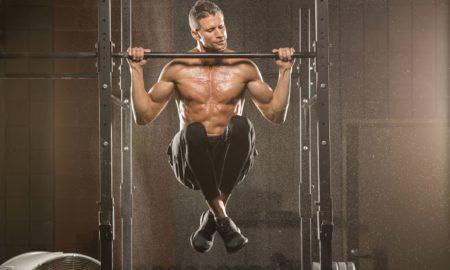Q: I recently watched the video of your cover shoot at IronManMagazine.com. I was particularly impressed with your abs and biceps and wonder if there’s anything special you did for those bodyparts. How do you train them? By the way, congrats on your cover, and great job on the video.
A: Thank you for your e-mail and for checking out IronManMagazine.com. I was thrilled to be chosen for the cover of IRON MAN. It was definitely a dream come true—shooting with Raven Lexy wasn’t exactly horrible either. Raven was really sweet and a lot fun to work with, but shooting for hours at a time is very hard work. If you look closely at the video or at the photos in my feature in that issue [January ’09], you’ll see that in some of the photos I’m covered in sweat—real sweat—particularly when I’m doing the leg and back exercises. That was at the end of the shoot, and I was dying, but it certainly was worth every moment. Michael Neveux does an absolutely masterful job with the photography, and I was blown away by how the guys at the IRON MAN studio edited the video.
Now, to answer your question: Most people don’t believe it, but I train abs only once a week when I’m preparing to be onstage for a competition or guest posing. Normally I train biceps once a week—typically on Friday—with about eight to 12 sets. Last year I felt my biceps were lagging a bit, so I threw in just about four sets of curls after my chest workout on Tuesdays to do a little extra biceps work without overtraining them. As you can see from the video, my strategy worked well.
I’ll give you my very simple routines for abs and biceps in a moment; first, I want to give you my big secret for effectively training those bodyparts. I concentrate on contracting the muscle as hard as I can on each rep. Let me repeat: I contract the muscle as hard as I can on every rep. I do my best to perform my exercises very smoothly so that momentum doesn’t take over, and I pause in the contracted position and consciously flex the muscle as hard as I can. I then return smoothly to the starting position, using the eccentric contraction of the target muscle to control the movement. To be quite honest, I use that technique on all isolation exercises, and it’s extremely effective.
My abdominal workout generally consists of two exercises. The first is a leg-raise-type exercise geared toward hitting the lower abs—hanging leg raises are my favorite—while the second exercise is a crunch movement to target the upper abs. I prefer to use Ab Slings when I do my leg raises, but if you don’t have any, you can hang from a chinup bar. I place a bench or a box under the bar to stand on while I’m getting situated in the Ab Slings, but I use it to control how far I can drop my legs at the bottom of the movement.
I start with my feet in front of the bench. I maintain a slight bend at the knees and slowly raise my legs until my ankles touch the bar. I’m careful to keep my head in a neutral position, and I exhale as I lift my legs. I flex my abs at the top of the movement and then consciously use my abs to control the speed of the descent. At the bottom my legs are still in front of the bench. They never go all the way under my body until I’m done with the set.
A couple of things to avoid are arching your back and swinging your legs. If you swing, your hip flexors will initiate the movement, and momentum will take over, with your abs doing very little work. I’ve had very few people who could do even one rep on the hanging leg raise the first time they tried. So for most people I recommend the hanging knee raise. Everything is the same except that you bend your knees as you lift your legs and bring them as high as possible. When I do them, I try to bring my knees to my elbows. Generally, I perform four sets of hanging leg raises, going to failure on each set.
Now I move on to crunches. I do them on the floor, on a bench or on a therapy ball. I don’t think I need to go into a description of how to do a crunch, but I’d like to offer a few pointers. First, always perform crunches smoothly. Feel your abs contracting from the starting position all the way to the top. Pause in the fully contracted position and flex your abs as hard as you can. Then feel your abs stretch as you return to the starting point. Don’t bounce and jerk on your crunches, and make sure that your lower back stays in contact with the bench or ball.
Pay particular attention to that if you do your crunches on a therapy ball. All too often I see people doing crunches on a ball and using their hips as the pivot point, and their lower backs come off the ball. To put maximum tension on the abdominals, keep your lower back on the ball, and push your hips forward as you crunch. Again, don’t forget to flex at the top. I usually do four sets of crunches, going to failure on each set.
That’s it: four sets of leg raises and four sets of crunches. Often my abdominals are actually cramping at the end of my last set or two of crunches.
For biceps I employ the same strategy that I use for abdominals. I go for maximum contraction on each rep. I usually do two curl exercises for four to five sets each for biceps, then hammer curls or reverse curls for three or four sets to target the brachialis. Currently my favorite biceps exercises are dumbbell curls and cable curls. You can use a straight bar or EZ-curl bar, and you can vary your grip width from narrow to shoulder width or slightly wider. The curl is a really simple movement, so rather than describe it in detail, I’ll give you my do’s and don’ts.
Do:
• Start with your shoulders back. That will stretch the long head of the biceps for more range of contraction.
• Keep your torso immobile.
• Perform the exercise smoothly and with control, both on the way up and on the way down.
• Consciously flex your biceps as hard as you can at the top of the movement.
• Keep your wrists straight or slightly back. That will keep tension on your biceps in the fully contracted position.
Don’t:
• Let your shoulders roll forward. That reduces the amount of tension on the long head of the biceps.
• Swing the weight. If you do, you get momentum going and there’s less tension on the biceps.
• Let your elbows move forward under the bar. Once your elbows are under the bar, you’re just supporting the weight. It’s no longer exerting tension on the biceps. Too many lifters let their elbows move in front of the weight so they rest at the top. Not good.
• Curl your wrists in. Curling the wrists reduces the distance between the resistance (the weight) and the fulcrum (your elbow), thus reducing the tension on the biceps.
• Relax and let the weight drop after you’ve gotten to the top of the movement. If you don’t use your biceps to control the weight’s descent back to the starting point, you totally miss out on the benefits of the eccentric contraction.
After four to five sets of scorching dumbbell curls and cable curls, I usually finish off my biceps workout with three to four sets of hammer curls. By then my brachialis is already pretty fatigued, so overkill is not necessary—and for me usually leads to tendinitis. I perform the hammer curls with dumbbells. It’s the same movement as the curl but with your palms facing in. I use the same techniques, moving the weight smoothly and flexing at the top.
By the way, I feel I should warn you: If you do my abdominal and biceps workouts exactly as I’ve described, squeezing out a maximum contraction on each repetition, be sure to have a fire extinguisher close by, or load up on Red Dragon, because your abs and biceps are going to be burning like crazy. I’ve trained bodybuilders who were doing 20 to 25 sets for biceps and hundreds of reps for abs who were begging for mercy after just four to six sets of strict reps with a full conscious contraction on each rep. Give it a whirl, and let me know how it goes.
Editor’s note: See Dave Goodin’s new blog at www.IronManMagazine.com. Click on the blog selection in the top menu bar. To contact Dave directly, send e-mail to [email protected]. IM




















You must be logged in to post a comment Login